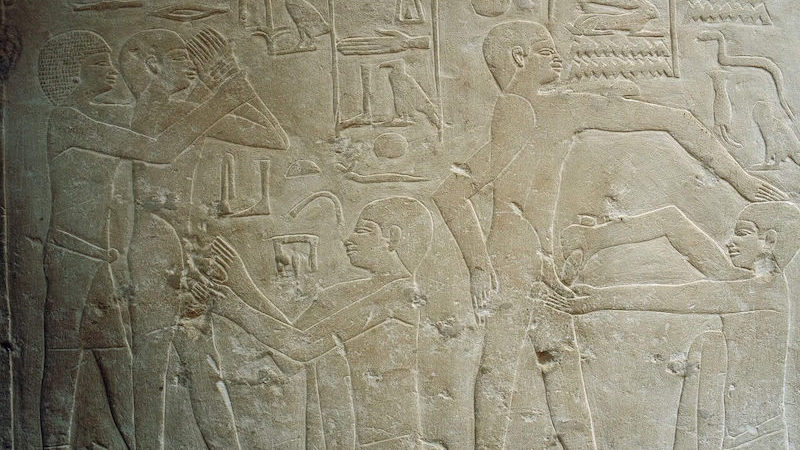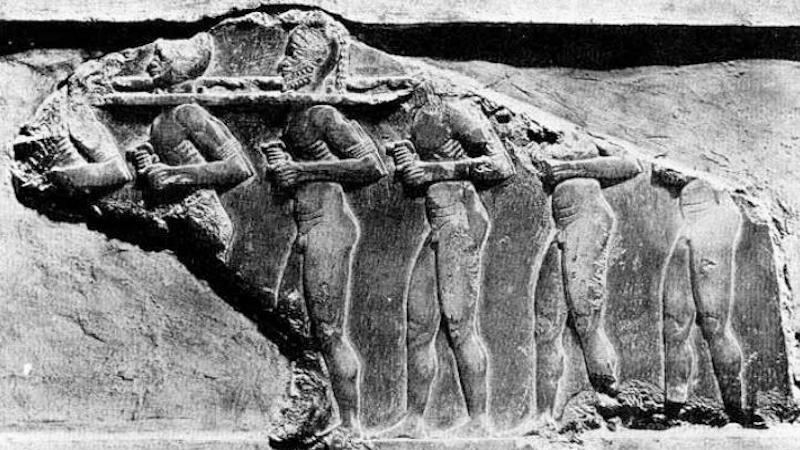When working with shame—particularly sexual shame—we continually encounter manifestations of the fear of being seen naked. For men at least, this fear is linked to ancestral traumas around slavery and circumcision.
The male fear of public nudity is not something that receives much attention. Yet it’s there, bubbling to the surface in certain situations. I’ve been posing as a life model for some years. I’ve never encountered a male who’s expressed anything other than abject horror at the prospect of public genital exposure.
Every fear has a functional cause, i.e., it originates in a specific experience of emotional overwhelm that becomes embodied, normalised, and genetically replicated. What was the functional cause of the male fear (and shame) of nudity?
Enforced nudity has historically been used to demonstrate power over defeated enemies and for public shaming. The Bible contains several examples, including 2 Samuel 10:4-5:
“Hanun arrested David’s officials and had their beards shaved off on one side of their faces. He had their robes cut off just below the waist, and then he sent them away. They were terribly ashamed.”
Beards were a sign of masculinity. Shaving off one side was symbolically an act of sexual humiliation, as was cutting off the robes. Yet there is a more specific chain of cause and effect linking nudity to slavery and circumcision.
Origins of circumcision
Circumcision is the oldest known surgical procedure, though its dating is inexact. Wikipedia claims that circumcised penises are found in Palaeolithic art though the reference they cite, by Javier Angulo and Marcos García-Díez, is equivocal:
“The genital representations performed in Europe during the Upper Palaeolithic period (38,000-11,000 years ago) allow us to infer the possible existence of a prehistoric practice of penile foreskin retraction or even circumcision.”
In Saharasia, geographer James DeMeo writes that “the earliest unambiguous evidence for circumcisioncomes from Egypt’s 6th Dynasty (ca. 2300 BCE)” in a bas-relief in the pyramid of Ankhmahor at Saqqara.

On the motive, Wikipedia states: “It has been speculated that circumcision originated as a substitute for castration of defeated enemies or as a religious sacrifice.”
Firstly, let’s keep in mind that this isn’t an either/or proposition; both may have been practiced at different times by different people. Let’s examine each of them.
Slavery and circumcision
Like circumcision, slavery predates written history but became widespread with the advent of patriarchy. Testimony by the captain of an Egyptian vessel in the campaigns against the Hyksos (16th century BC) reads:
“Then Avaris was despoiled. Then I carried off spoil from there: one man, three women, a total of four persons. Then his majesty gave them to me to be slaves.”
Male slaves were very useful, but they came with a risk: sex. Dominant cultures were obsessed with protecting their genetic superiority. Male slaves in elite households had potential access to women of the ruling class. The obvious solution was castration. No dick, no sex.
The problem with castration was that it caused heavy blood loss, resulting in a high mortality rate. All that despoiling for nothing.
Circumcision was a compromise. Although it didn’t physically prevent penetration, it turned sex into a psychologically traumatic act. Moses Maimonides, physician and rabbi of Cairo (ca. 1175) writes:
“The true purpose of circumcision was to give the sexual organ that kind of physical pain as not to impair its natural function or the potency of the individual, but to lessen the power of passion and of too great desire.”
Insult sensitivity
DeMeo’s research reveals a high correlation between the practices of slavery and genital mutilation. These also correlate with “insult sensitivity is extreme.” Cultures that practiced slavery and genital mutilation were highly attuned to shame.
They inflicted shame on others and avoided it themselves—at all costs, as we’ll see.
One means of inflicting humiliation—as per 2 Samuel 10 above—was forcing male slaves to go naked. This revealed their circumcision for all the world to see. It was the ineradicable mark of a slave. The stela above shows naked male slaves in the near east in the 3rd millennium BC, believed to be Akkadian captives.
Nudity revealed circumcision which revealed slavery. In societies with extreme insult insensitivity, this was intolerable. Now do you see why a profound fear of nudity might be lurking in the depths of the male collective unconscious.
Eradicating the ineradicable
The history of the early patriarchies shows that tribes, cultures, and empires rose and fell with bewildering rapidity. Victors became vanquished and vice-versa. The plight of the Israelites—from exile in Egypt to their own kingdom to conquest by Babylon—neatly illustrates this pattern.
The shamed became the shamers—but also had to deal with the fact that they bore the shameful mark of circumcision. The ineradicable had to be eradicated.
Genesis 17 tells how God instructed Abraham to circumcise all male Israelites. This makes it sound like circumcision spontaneously appeared as a religious practice—the second theory on its origins—yet the practice was already widespread in the region.
In The Harlot by the Side of the Road, Jonathan Kirsch writes that “circumcision was… practiced by the Egyptians and many of the native-dwelling peoples of Canaan… the Bible identifies only the Philistines… as uncircumcised.”
There is a clear functional driver to turn circumcision—the enforced mark of a slave—into a religious practice and ethnic identifier. Yet the underlying shame remains.
That this practice was shame-based is made clear in Exodus 28:42-43: “Make linen shorts for them… so they won’t expose themselves. Whenever they enter the sacred tent… they must wear these shorts, or else they will be guilty and die.”
Every priest in history has entered the temple bearing the signs and regalia of their covenant with God. If circumcision was the mark of God, why the mortal shame of displaying it?
Psychic wound
Exodus 28 again highlights the extreme fear of public nudity.
Why all this fuss over a fear that rarely, if ever, manifests? After all, the proportion of men who participate in life drawing is minuscule.
Historically, circumcision was intended to inflict profound psychosexual pain—deep enough to stop you messing with your enemy’s women. That pain became embedded in the collective psyche, passed down through generational trauma. As a psychic wound, it’s there whether you’ve been circumcised or not.
Few are aware of this wound, yet it surfaces in subtle ways—like the prevalence of violence in pornography, and the flutter of fear at the prospect of male public nudity.
Every fear has a functional cause. That a little ripple of fear on the surface of 21st century life conceals a deep trauma from the ancient past—and provides access to it.
Everything that happened 6,000 years ago at the dawn of patriarchy is still happening today, just in a deeply buried, subterranean way—because no one has healed it.
On the road to healing ancestral traumas and restoring male sexual functioning, we must contend with slavery, circumcision, and the fear of nudity.
Next steps
For further resources on sexuality, both free and paid, please click on this image.
Image: Unknown stela, believed to show Akkadian war captives (third millennium BC). Sargon of Akkad (ca. 2400-2300 BC) is considered the world’s first emperor.


